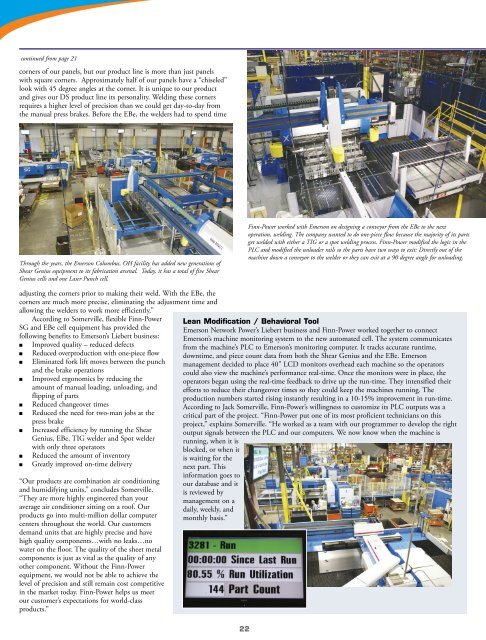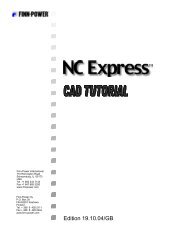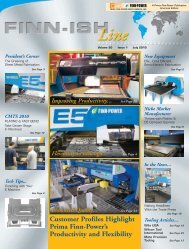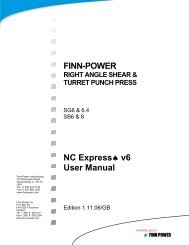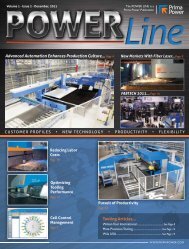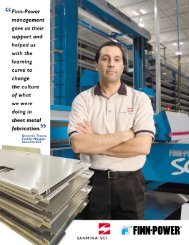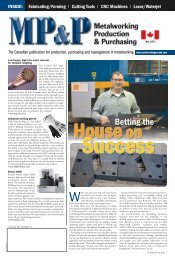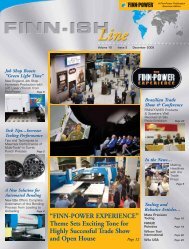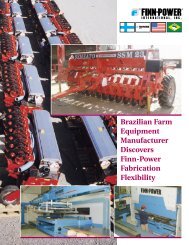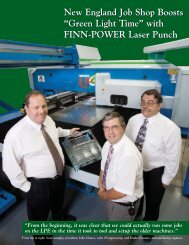Volume 20 Issue 2 - Finn-Power International, Inc.
Volume 20 Issue 2 - Finn-Power International, Inc.
Volume 20 Issue 2 - Finn-Power International, Inc.
You also want an ePaper? Increase the reach of your titles
YUMPU automatically turns print PDFs into web optimized ePapers that Google loves.
continued from page 21<br />
corners of our panels, but our product line is more than just panels<br />
with square corners. Approximately half of our panels have a “chiseled”<br />
look with 45 degree angles at the corner. It is unique to our product<br />
and gives our DS product line its personality. Welding these corners<br />
requires a higher level of precision than we could get day-to-day from<br />
the manual press brakes. Before the EBe, the welders had to spend time<br />
Through the years, the Emerson Columbus, OH facility has added new generations of<br />
Shear Genius equipment to its fabrication arsenal. Today, it has a total of five Shear<br />
Genius cells and one Laser Punch cell.<br />
adjusting the corners prior to making their weld. With the EBe, the<br />
corners are much more precise, eliminating the adjustment time and<br />
allowing the welders to work more efficiently.”<br />
According to Somerville, flexible <strong>Finn</strong>-<strong>Power</strong><br />
SG and EBe cell equipment has provided the<br />
following benefits to Emerson’s Liebert business:<br />
■ Improved quality – reduced defects<br />
■ Reduced overproduction with one-piece flow<br />
■ Eliminated fork lift moves between the punch<br />
and the brake operations<br />
■ Improved ergonomics by reducing the<br />
amount of manual loading, unloading, and<br />
flipping of parts<br />
■ Reduced changeover times<br />
■ Reduced the need for two-man jobs at the<br />
press brake<br />
■ <strong>Inc</strong>reased efficiency by running the Shear<br />
Genius, EBe, TIG welder and Spot welder<br />
with only three operators<br />
■ Reduced the amount of inventory<br />
■ Greatly improved on-time delivery<br />
“Our products are combination air conditioning<br />
and humidifying units,” concludes Somerville.<br />
“They are more highly engineered than your<br />
average air conditioner sitting on a roof. Our<br />
products go into multi-million dollar computer<br />
centers throughout the world. Our customers<br />
demand units that are highly precise and have<br />
high quality components…with no leaks…no<br />
water on the floor. The quality of the sheet metal<br />
components is just as vital as the quality of any<br />
other component. Without the <strong>Finn</strong>-<strong>Power</strong><br />
equipment, we would not be able to achieve the<br />
level of precision and still remain cost competitive<br />
in the market today. <strong>Finn</strong>-<strong>Power</strong> helps us meet<br />
our customer’s expectations for world-class<br />
products.”<br />
Lean Modification / Behavioral Tool<br />
Emerson Network <strong>Power</strong>’s Liebert business and <strong>Finn</strong>-<strong>Power</strong> worked together to connect<br />
Emerson’s machine monitoring system to the new automated cell. The system communicates<br />
from the machine’s PLC to Emerson’s monitoring computer. It tracks accurate runtime,<br />
downtime, and piece count data from both the Shear Genius and the EBe. Emerson<br />
management decided to place 40” LCD monitors overhead each machine so the operators<br />
could also view the machine’s performance real-time. Once the monitors were in place, the<br />
operators began using the real-time feedback to drive up the run-time. They intensified their<br />
efforts to reduce their changeover times so they could keep the machines running. The<br />
production numbers started rising instantly resulting in a 10-15% improvement in run-time.<br />
According to Jack Somerville, <strong>Finn</strong>-<strong>Power</strong>’s willingness to customize its PLC outputs was a<br />
critical part of the project. “<strong>Finn</strong>-<strong>Power</strong> put one of its most proficient technicians on this<br />
project,” explains Somerville. “He worked as a team with our programmer to develop the right<br />
output signals between the PLC and our computers. We now know when the machine is<br />
running, when it is<br />
blocked, or when it<br />
is waiting for the<br />
next part. This<br />
information goes to<br />
our database and it<br />
is reviewed by<br />
management on a<br />
daily, weekly, and<br />
monthly basis.”<br />
22<br />
<strong>Finn</strong>-<strong>Power</strong> worked with Emerson on designing a conveyor from the EBe to the next<br />
operation, welding. The company wanted to do one-piece flow because the majority of its parts<br />
get welded with either a TIG or a spot welding process. <strong>Finn</strong>-<strong>Power</strong> modified the logic in the<br />
PLC and modified the unloader rails so the parts have two ways to exit: Directly out of the<br />
machine down a conveyor to the welder or they can exit at a 90 degree angle for unloading.


